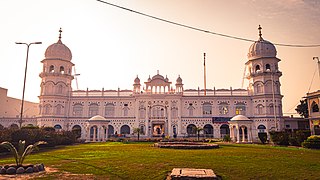Related Research Articles

The Chishtī Order is a Sunni Sufi order within the mystic Sufi tradition of Islam. It began in Chisht, a small town near Herat, Afghanistan, about 930 CE. The Chishti Order is known for its emphasis on love, tolerance, and openness. Chishti Sharif is name of village in Afghanistan near Iran border.

Muhammad Nizamuddin Auliya, also known as Hazrat Nizamuddin, and Mahbub-e-Ilahi was a Sunni Muslim scholar, Sufi saint of the Chishti Order, and is one of the most famous Sufis from the Indian Subcontinent. His predecessors were Fariduddin Ganjshakar, Qutbuddin Bakhtiyar Kaki, and Moinuddin Chishti, who were the masters of the Chishti spiritual chain or silsila in the Indian subcontinent.
Chishtī Muʿīn al-Dīn Ḥasan Sijzī, known more commonly as Muʿīn al-Dīn Chishtī or Moinuddin Chishti or Khwājā Ghareeb Nawaz, or reverently as a Shaykh Muʿīn al-Dīn or Muʿīn al-Dīn or Khwājā Muʿīn al-Dīn by Muslims of the Indian subcontinent, was a Persian Muslim preacher, ascetic, religious scholar, philosopher, and mystic from Sistan, who eventually ended up settling in the Indian subcontinent in the early 13th-century, where he promulgated the famous Chishtiyya order of Sunni mysticism. This particular tariqa (order) became the dominant Muslim spiritual group in medieval India and many of the most beloved and venerated Indian Sunni saints were Chishti in their affiliation, including Nizamuddin Awliya and Amir Khusrow. As such, Muʿīn al-Dīn Chishtī's legacy rests primarily on his having been "one of the most outstanding figures in the annals of Islamic mysticism." Additionally Muʿīn al-Dīn Chishtī is also notable, according to John Esposito, for having been one of the first major Islamic mystics to formally allow his followers to incorporate the "use of music" in their devotions, liturgies, and hymns to God, which he did in order to make the foreign Arab faith more relatable to the indigenous peoples who had recently entered the religion or whom he sought to convert. Others contest that the Chisti order ever permitted musical instruments and a famous Chisti, Nizamuddin Auliya, is quoted as stating that musical instruments are prohibited.

A dargah is a shrine built over the grave of a revered religious figure, often a Sufi saint or dervish. Sufis often visit the shrine for ziyarat, a term associated with religious visits and “pilgrimages”. Dargahs are often associated with Sufi eating and meeting rooms and hostels, called khanqah or hospices. They usually include a mosque, meeting rooms, Islamic religious schools (madrassas), residences for a teacher or caretaker, hospitals, and other buildings for community purposes. The same structure, carrying the same social meanings and sites of the same kinds of ritual practices, is called maqam in the Arabic-speaking world. Dargah is a place where saints prayed and mediated. Shrine is modern day building which encompasses of actual dargah as well but not always.

Farīd al-Dīn Masʿūd Ganj-i-Shakar was a 12th-century Punjabi Muslim preacher and mystic. who went on to become "one of the most revered and distinguished ... Muslim mystics" of the medieval period. He is known reverentially as Bābā Farīd or Shaikh Farīd by Muslims, Sikhs and Hindus of the Punjab Region, or simply as Farīduddīn Ganjshakar.

Nizamuddin Dargah is the dargah (mausoleum) of the Sufi saint Khwaja Nizamuddin Auliya. Situated in the Nizamuddin West area of Delhi, the dargah is visited by thousands of pilgrims every week. The site is also known for its evening qawwali devotional music sessions. The descendants of Nizamuddin Auliya look after the whole management of dargah Sharif.

Sirhind-Fatehgarh is a city and a municipal council in the Fatehgarh Sahib district in the Indian state of Punjab.

Gurdwara Darbar Sahib Kartarpur, also called Kartarpur Sahib, is a gurdwara in Kartarpur, located in Shakargarh, Narowal District, in the Punjab province of Pakistan. It is built on the historic site where the founder of Sikhism, Guru Nanak, settled and assembled the Sikh community after his missionary travels and lived for 18 years until his death in 1539. It is one of the holiest sites in Sikhism, alongside the Golden Temple in Amritsar and Gurdwara Janam Asthan in Nankana Sahib.
Ustad Bahauddin Khan Qawwal was a Pakistani Qawwali musician.
Most holy sites in Sufism are shrines dedicated to various Sufi Saints - spiritually elevated ascetics from various mystical orders within Islam. Shrines are widely scattered throughout the Islamic world. Pilgrimages to them are known as Ziyarat. Traditional annual commemorations of the saint's death held at his shrine are known as Urs In several countries, the local shrine is a focal point of the community, with several localities named specifically for the local saint.

Gurdwara Janam Asthan, also referred to as Gurdwara Nankana Sahib, is a highly revered gurdwara that was built at the site where the founder of Sikhism, Guru Nanak, was believed to be born. The shrine is located in the city of Nankana Sahib, near the city of Lahore in the Punjab province of Pakistan.
Religion and spirituality, a pilgrimage is a long journey or search of great moral significance. Sometimes, it is a journey to a sacred place or shrine of importance to a person's beliefs and faith. Members of every major religion participate in pilgrimages. A person who makes such a journey is called a pilgrim.

Ajmer Sharif Dargah, Ajmer Dargah, Ajmer Sharif or Dargah Sharif is a sufi shrine (dargah) of the revered sufi saint, Moinuddin Chishti, located at Ajmer, Rajasthan, India. The shrine has Chisti's grave (Maqbara).
Shaheed Ganj Mosque, originally named after the Gurdwara it was built across was commissioned during the reign of Mughal Emperor Alamgir II and built by Abdullah Khan construction was completed in 1758 it was constructed next to the small Gurdwara decimated to a shrine, in memory of Taru Singh martyrdom in refusing to convert to Islam along with the Mughal slaughter of 100,000 Sikh men, women and children and was located in Naulakha Bazaar area of Lahore, Punjab, Pakistan. Sikh rule began in 1762, the Gurdwara Bhai Taru Singh was built afterwards on the reduced shrine that had been a makeshift Gurdwara.

Syed Zainul Abedin is the Dewan of the Ajmer Sharif Dargah founded by Khawaja Moinuddin Chishti, according to the APEX Court of India. He is the successor of Khwaja Gareeb Nawaz, and is also known as Dargah Dewan, successor, Sajjadanashin of the Chishti order of Sufism, Gaddinashin, Pir and Sheikhul Mashaeikh Dewan Syed Zainul Abedin Ali Khan Sahib of the Ajmer Sharif Dargah.

The Shrine of Baba Farid is a 13th-century Sufi shrine located in Pakpattan, Pakistan, that is dedicated to the Sufi mystic Fariduddin Ganjshakar, popularly known as Baba Farid. The shrine is one of the most important in Pakistan, and was among the first Islamic holy sites in South Asia – providing the region's Muslims a local focus for devotion. The shrine is also revered by Sikhs, who include Baba Farid's poetry into the Guru Granth Sahib - regarded by Sikhs to be the eternal Guru.

The Kartarpur Corridor is a visa-free border crossing and secure corridor, connecting the Gurdwara Darbar Sahib in Pakistan to the border with India. The crossing allows Sikh devotees from India to visit the gurdwara in Kartarpur, 4.7 kilometres from the India–Pakistan border on the Pakistani side without a visa. However Pakistani Sikhs are unable to use the border crossing, and cannot access Dera Baba Nanak on the Indian side without first obtaining an Indian visa or unless they work there.

The Gurdwara Shahid Ganj Singh Singhania, also known as Gurdwara Shaheedganj Singh Singhnian, is a historic Sikh Gurdwara at Naulakha Bazaar in Lahore, Pakistan, which marks the site where over 100,000 Sikh men and women lost their lives in the 18th Century. It is located opposite Gurudwara Bhai Taru Singh. Bhai Mani Singh was martyred at this site on 14 June 1738.
References
- ↑ "Pant-Mirza Agreement". Press Information Bureau, National Informatics Centre (NIC), India. Archived from the original on 2018-12-14. Retrieved 2018-12-11.
- ↑ "Protocol on visits to Religious Shrines". Ministry of External Affairs, India. 14 September 1974. Archived from the original on 2018-12-14. Retrieved 2018-12-11.
- ↑ "Q.*316 Denial of visa by Pakistan". Institute for Defence Studies and Analyses. 24 August 2011. Retrieved 2018-12-11.
- 1 2 "Express Fact Check | Visas for pilgrims: 15 shrines in Pak, 5 in India under protocol". The Indian Express. 27 November 2018. Archived from the original on 2018-12-14. Retrieved 2018-12-11.